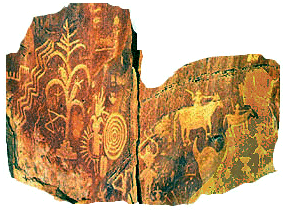
 
|
A grueling 300-mile march to imprisonment in a sterile land.
The Diné, or Navajo as they were called by the Spanish, share a common Athabascan ancestry with the Apache. The Diné emulated the Pueblo, shedding their animal skin clothing for cotton and learning quickly to farm. They settled in, herding sheep and growing corn in the canyons and mesas between the Rio Grande and the Grand Canyon. When American settlers started filtering into the area, raids began. Attempts to negotiate treaties were made between 1846 and 1849, but the Diné, a population of approximately 12,000, were vastly scattered, and coordinated talks never took place. In 1851, Fort Defiance was built about 30 miles southeast of Canyon de Chelly. The land that had been long used for grazing Navajo sheep was suddenly taken over for use by the soldier's horses. A long cycle of bloody attacks and reprisals began, peaking in 1860, when 1,000 warriors waged an attack on Fort Defiance. The army abandoned the fort, but a full-fledged campaign of revenge cut across Navajo country. Crops were burned and destroyed, livestock was slaughtered or confiscated, and the Diné faced the threat of starvation. A peace agreement was signed in 1861, which included a government promise of rations for the tribe. Later that year, the supplies were distributed in a festive atmosphere which included horse racing and betting. In the last race, an army rider accused of cheating was declared winner, and an uproar followed. The troops withdrew to the fort where the commander ordered them to open fire. More than 30 Navajo were shot dead, many of them women and children. This initiated an new wave of vengeance.
In 1863, Colonel Christopher "Kit" Carson was named by General Carlton (known for his ruthless treatment of Apache raiders) to begin a campaign against the Navajo. His troops stormed into the ancient and sacred Canyon de Chelly, rousting the people from their hogans which were then burned, along with saddles, clothing and all other stores. Their sheep and cattle were slaughtered, and about two million pounds of corn burned. Families attempted to hide in caves in the canyon walls, but were hunted and put under armed guard. One small band of Kayenta Navajo found fresh-water springs in a hidden canyon behind the top of Navajo Mountain, and were able to escape captivity. After many months of bitter imprisonment, about 8,000 men, women and children were forced to make a grueling 300-mile forced march, remebered as "the Long Walk," across New Mexico to a dry desolate strip of land known as Bosque Renondo. There, Carleton invisioned, they would become "happy and contented people." Navajo men were forced to mold adobes and to build Fort Sumner. They were given no wood for fires, the drinking water was bitter and the soil no good for growing corn. Men, women and children became ill, developing stomach problems and other conditions due to the lack of fires to withstand the cold winter rain and wind. Without their land and their corn, the people were in a state of desperation, made worse by disease and starvation. They were wasting away. Ultimately, the imprisoment has its desired effect. A treaty was signed in 1868, granting Navajo survivors a 3.5 million acre reservation which included their old home country.
During their imprisonment, the Navajo lost about 25% of their people, and were no longer considered a threat. They returned home and began to rebuild their homes and their lives.
|
 Recorded in petroglyph form, these symbols, found in Largo Canyon, New Mexico, tell the story of Carson's campaign against the Navajo.
Recorded in petroglyph form, these symbols, found in Largo Canyon, New Mexico, tell the story of Carson's campaign against the Navajo.
